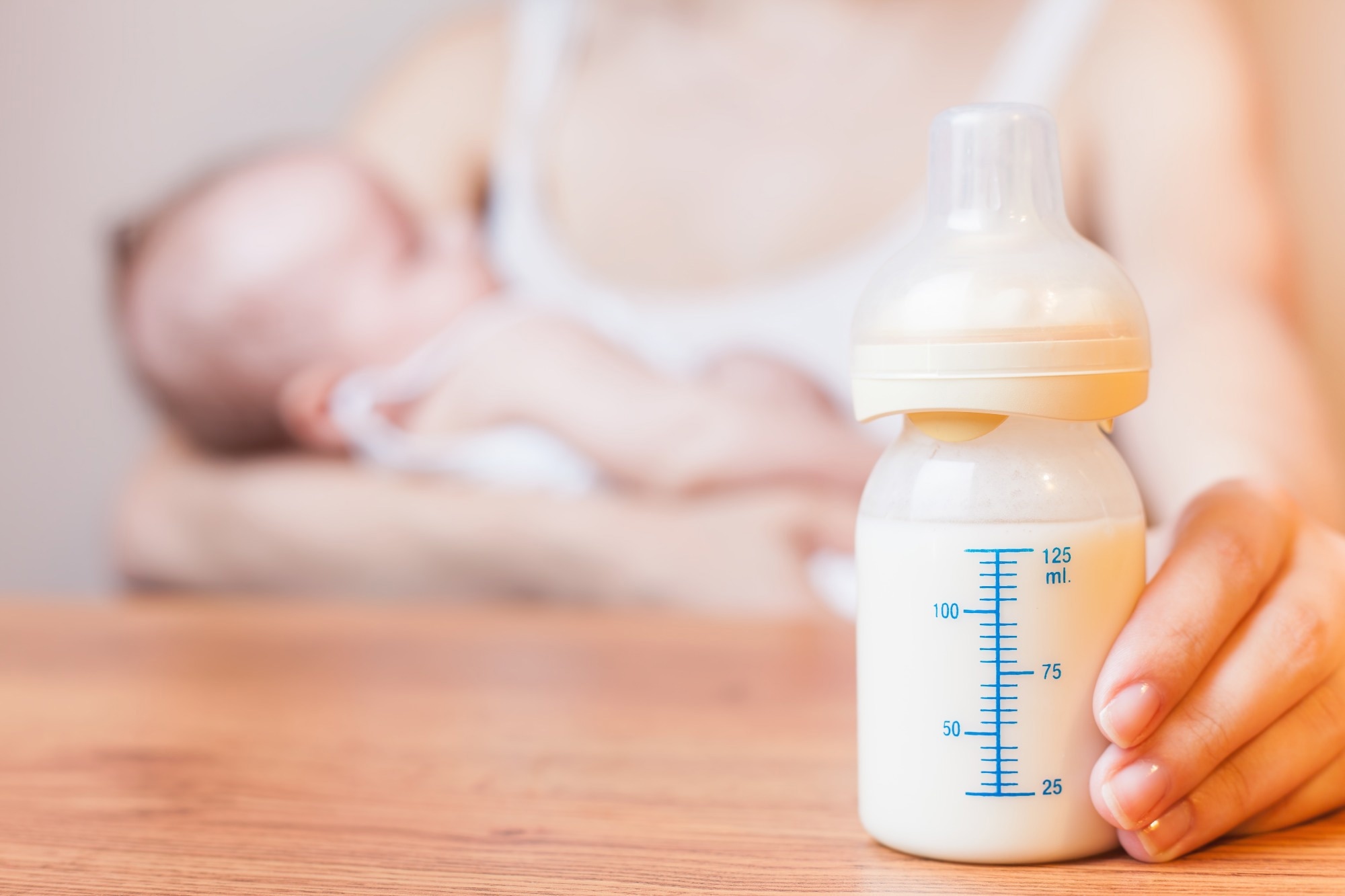A new paper published in the Frontiers in Microbiology explores the contribution of human breast milk to the establishment of the infant gut microbiome.
Study: Human milk-associated bacterial communities associate with the infant gut microbiome over the first year of life. Image Credit: Pavel Ilyukhin / Shutterstock.com
Introduction
Breastfeeding is encouraged as the first and exclusive food of infants for at least the first six months of life. In addition to its nutritional content, breast milk contributes significantly to the formation of the infant gut microbiome. This is because of its high content of immune cells, oligosaccharides carrying glycosyl residues, fatty acids, and some microbes.
Both breast milk bacteria and skin microbes from the maternal nipple reach and establish themselves in the infant’s gut. Bacteria may be shielded by secretory immunoglobulin A (sIgA) covering the immune system, thus allowing them to enter the gut intact.
The infant gut microbiome (IGMB) is important for both infant development and immunity, as well as modulating conditions like atopy and body mass composition. However, earlier research on potential associations between the IGMB and breast milk microbiota has been limited to analyzing samples from corresponding time points.
The current study included almost 190 dyads from New Hampshire. Breast milk and infant stool samples were collected at around six weeks, four months, six months, nine months, and one year from birth, which allowed the scientists to identify correlations that developed over time.
What did the study show?
In the study population, with a mean age of 32 years, most were White and had a normal body mass index (BMI) during pregnancy. About 25% of deliveries occurred through Cesarean section (C-section), and antibiotic exposure prior to lactation occurred in over half of mothers.
Most babies were almost full term at birth, with only 3% being exposed to antibiotics by four months of life. By one year, about 30% of infants had been exposed to antibiotics.
About 75% and 40% of infants did not receive any formula up to six weeks and four months, respectively. Most infants began eating solid food by six months.
Three breast milk microbiome types (BMTs) were identified in the six-week breast milk samples. These could be differentiated by the relative proportions of four bacterial genera, including Streptococcus, Staphylococcus, Pseudomonas, and Acinetobacter, as well as by the microbial diversity.
At six weeks, the gut microbiome in infants exhibited four six-week infant gut microbiome types (6wIGMTs). These had different abundances of Bifidobacterium, Bacteroides, Clostridium, Streptococcus, and Escherichia/Shigella.
The 6wIGMT correlated with the 6wBMT in male infants and those born by C-section. Notably, the same microbe was likely to be the most abundant within the dyads at this point.
By age one, the predominant difference in microbiome composition was due to Bacteroides. There was no association between the 6wBMT and 12mIGMT, which is likely due to the intake of solid foods by infants at this age. The transition to a primarily solid diet causes the infant microbiome to be dominated by other microbes, such as Bifidobacterium and Bacteroidetes, both of which are more abundant in the adult gut.
At six weeks, the BMT was associated with 6wIGMT in all infants but more strongly in male infants born by C-section. Male infants also had a higher proportion of microbes from breast milk present in their stool.
While infants delivered by C-section have a reduced colonization by maternal stool microbiota, their colonization by breast milk microbiota is higher than vaginally delivered infants.”
This could be due to the reduced microbial diversity and Bacteroides depletion in the IGMB of C-section-delivered infants, which makes it easier for breast milk microbes to colonize the gut.
Male infants appeared to show a greater effect of the breast milk microbes on their gut microbiome. This may be because they exhibit less microbial diversity, with fewer Clostridiales and more Enterobacteriales abundance than is observed in female infants. The male infant’s gut microbiota is also more susceptible to stress and environmental exposures.
Overall, the breast milk microbial communities correlated most strongly with those found in infant stool samples that were collected at a later time point. For example, Pantoea in breast milk at four and six months was correlated with infant stool collected at nine and twelve months, respectively. These findings require further validation in future research.
What are the implications?
The identification of microbial clusters in human milk and infant feces that were shared within the mother-infant pair at six weeks is a striking finding in this study. The delay in cluster sharing and the association with C-section were associated with stronger correlations.
The findings of this study agree with earlier reports on the associations of various microbes in breast milk and the infant gut. Notably, the current study adds to previous data by identifying correlations between different taxa in these two sites.
The scientists postulate that microbes within communities may show direct interactions, such as the transmission of a microbe present in the infant oral cavity to the breast in this case, as well as the intake of breast milk by the infant. In addition, they may show indirect interactions through nutrients like fatty acids and milk sugars or other bacterial metabolites that influence both communities.
With the observed shift in breast milk microbial diversity over time, long-term studies may be needed to understand the breadth of microbial exposures during infancy. The change in IGMTs over time should also be better characterized and their relevance assessed.
These results suggest that milk microbial communities have a long-term effect on the infant gut microbiome both through sharing of microbes and other molecular mechanisms.”
Journal reference:
- Lundgren, S. N., Madan, J. C., Karagas, M. R., et al. (2023). Human milk-associated bacterial communities associate with the infant gut microbiome over the first year of life. Frontiers in Microbiology. doi:10.3389/fmicb.2023.1164553.
